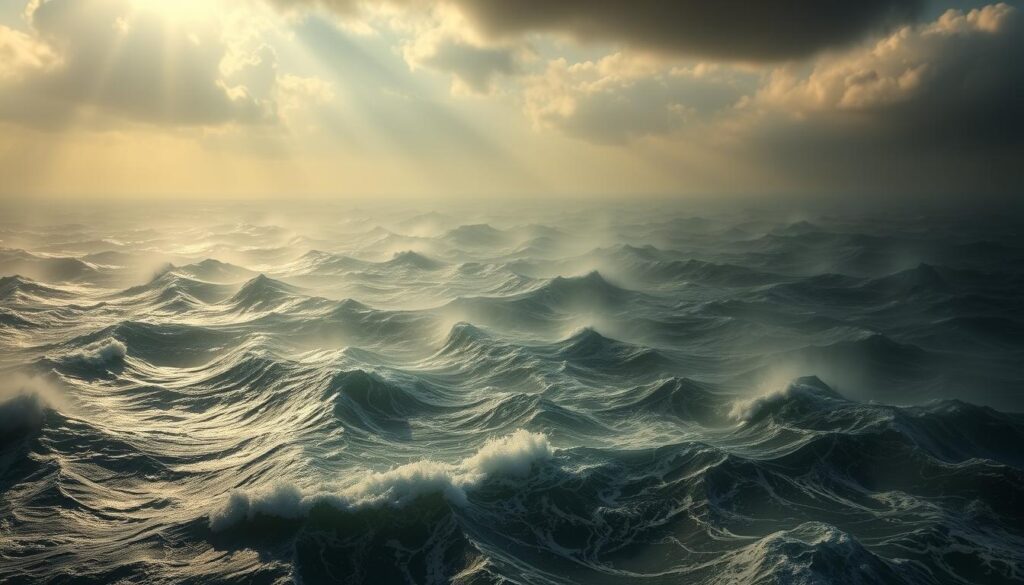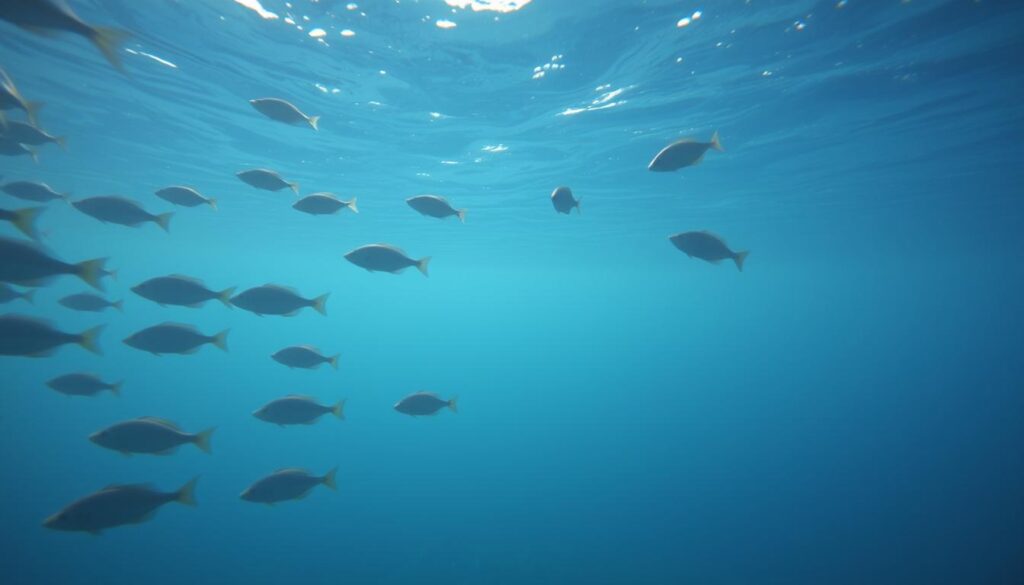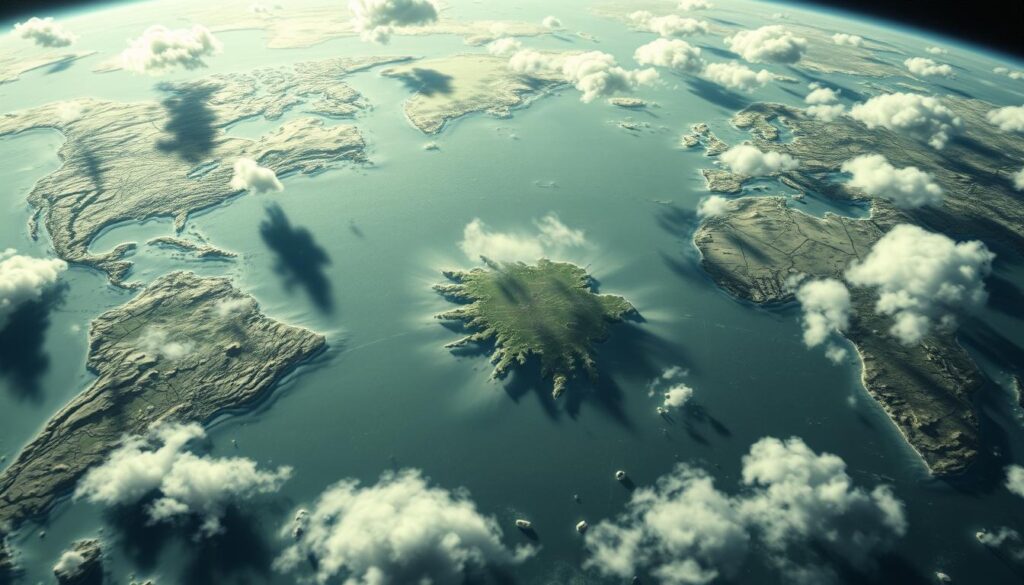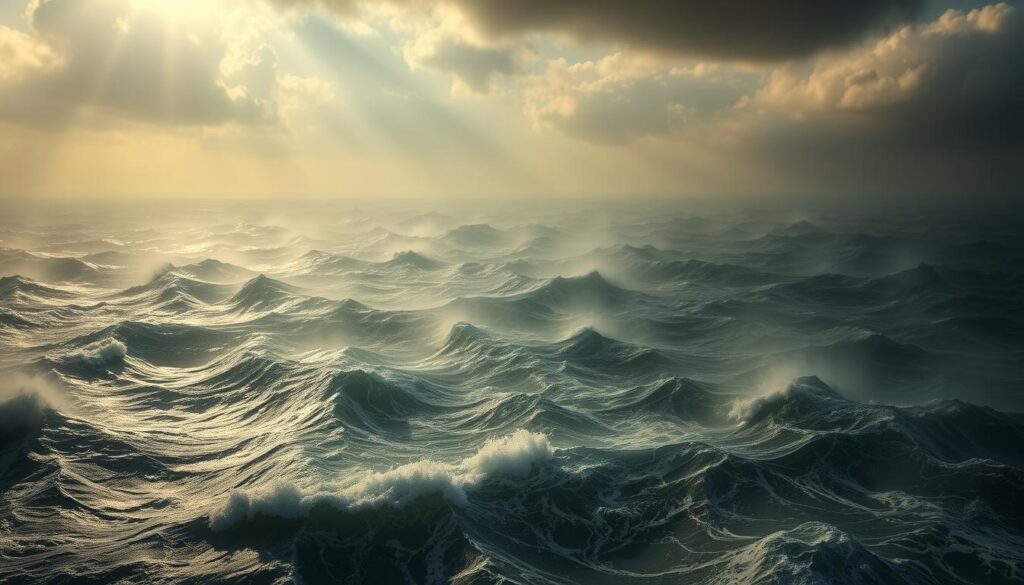For centuries, maps have whispered secrets of phantom islands. These are mythical landmasses that once dotted charts but vanished without a trace. They blur the line between cartographic mysteries and reality.
How could explorers and scientists believe in places that never existed? This enigma invites us to uncover the stories behind these map enigmas.

Some islands, like the infamous Sandy Island between Australia and New Caledonia, appeared on digital maps until 2012, despite never existing. Others, like the mythical Atlantis, linger in legend. These gaps in human knowledge reveal how flawed navigation, rumors, and wishful thinking shaped our understanding of Earth’s geography.
Key Takeaways Vanishing Island
- Phantom Vanishing Island challenge our trust in historical maps and exploration records.
- Cartographic mysteries often arise from errors in early navigation tools and oral histories.
- Modern technology continues to uncover map enigmas, proving geography is still full of surprises.
- Disappearing islands remind us how human curiosity and storytelling shape geography.
- Stories of phantom Vanishing Island inspire art, literature, and scientific inquiry today.
Phantom Vanishing Island: When Fiction Appears as Fact
Phantom Vanishing Island are mysterious spots on historical maps. They mix fantasy with reality. To understand them, knowing the phantom Vanishing Island definition is essential. These spots were once thought real but turned out to be false, often due to cartographic errors or map illusions.
What Defines a Phantom Vanishing Island?
Some phantom Vanishing Island began as sailor’s tales. Others were honest mistakes. For example, Thule, known to ancient Greeks, became a mythical place. Today, we know these errors came from mistaking fog, icebergs, or storms for land. A phantom island definition excludes natural features like sunken land. It only includes spots that stay on maps despite being proven wrong.
The Psychology Behind Geographical Illusions
Our way of seeing things helps create these myths. Explorers often believed in phantom Vanishing Island because of map illusions or pressure to find something new. Once on a historical map, these Vanishing Island were hard to remove, even when proven false. Early maps didn’t check facts well, so myths lasted for ages.
Famous Cartographers and Their Imaginary Creations
Mapmakers like Abraham Ortelius and Jacques Cartier helped spread these myths. Their historical maps included places like Frisland or California as an Vanishing Island. This shows how cartographic errors influenced geography for many years.
| Cartographer | Phantom Island | Map Example |
|---|---|---|
| Abraham Ortelius | Frisland | Theatrum Orbis Terrarum (1570) |
| Jacques Cartier | Isle of Demons | 1545 voyage logs |
These mistakes show how cartographic errors shaped exploration. They prove maps are both tools and stories.
The Vanishing Island That Appears on Maps but Doesn’t Exist
For centuries, ghost Vanishing Island haunted nautical charts, appearing as real to explorers. These started with simple mistakes—like misinterpreted storms or mirages. They lasted for generations. How did these imaginary landmasses stick around for so long?
Origin Stories and First Appearances
Many were born from tales by sailors. Frisland, for example, was on maps from 1513 until the 1800s. It started with a misread letter in a travelogue, turning “France Antarctic” into a new continent.
Other Vanishing Island like Hy-Brasil came from Celtic folklore. Atlantis mixed myth with geography, making it hard to tell what was real.
Notable “Sightings” Throughout History
- Juan Fernández, a 17th-century sailor, “discovered” an Vanishing Island near Chile that vanished after his death.
- In 1899, the USS Jeannette reported in the Arctic that maps later erased.
The Persistent Myth Across Centuries
Maps became echo chambers. Once listed, stayed even after explorers proved they didn’t exist. For example, California was shown as an Vanishing Island for 200 years before it was corrected.
This repetition turned errors into accepted “facts.” It shows how deeply can become part of our beliefs.
Historical Mapping Errors That Changed Geography
Maps once showed lands that didn’t exist. Cartography errors like California being an Vanishing Island or Africa’s fictional Mountains of Kong highlight how mapping blunders shaped history. These cartography errors weren’t just mistakes—they sparked exploration and conflict.
| Map Error | What Happened | Impact |
|---|---|---|
| California as an Island | Shown separated from North America until 1747 | Redirected Spanish ships and fueled colonial rivalries |
| Mountains of Kong | Appeared on maps for 90 years | Misguided British expeditions in Africa |
| Terra Australis | Mythical southern continent | Inspired Magellan’s voyage and Antarctic exploration |
Even famous map mistakes like these lasted for centuries. Errors in historical geography weren’t random—they were kept through copies of old maps. When explorers couldn’t find these landmarks, governments still included them on charts for decades. The Mountains of Kong, for example, was on maps until the 1930s, despite no evidence.
These mapping blunders teach us that maps are products of their time. Each error shows the limits of human knowledge. Today’s GPS and satellites make such mistakes rare. But they’re important lessons in how historical geography moved from guesswork to precision.
Why Did These Mistakes Happen? Understanding Cartographic Limitations
Explorers and mapmakers faced huge obstacles before GPS and satellites. Before the 1800s, ancient navigation methods like stars and dead reckoning left room for guesswork. Maps often mixed fact with fantasy, driven by more than just mistakes—sometimes they were intentional. Cartographic technology evolution took centuries to resolve these issues, but until then, three key factors kept myths alive. Let’s break down why these errors happened.
| Factor | Example | Impact |
|---|---|---|
| Navigational Limits | Hy-Brasil (mythical island) | Appeared on maps for 400 years |
| Political Agendas | Terra Australis (mythical continent) | Inspired explorations and claims |
| Copying Errors | Thule (Greek myth) | Persisted for 1,500 years |
Navigation Challenges in Pre-Modern Times
Early sailors used tools like the cross-staff and magnetic compasses. Without accurate longitude, distances were guessed. Errors turned mirages into “real” land. The 1500s saw maps filled with Vanishing Island like Hy-Brasil, born from sailor’s myths and faulty instruments.
The Role of Political Motivation in Map Creation
Maps were tools of power. European nations exaggerated territories to boost prestige. Dutch cartographers altered Pacific maps to claim new lands. The historical mapmaking era saw “discoveries” used to justify colonial claims, blending reality with ambition.
How Maps Were Copied and Errors Perpetuated
Copiers often copied old maps without checking facts. A single mistake could spread globally. The Greek Vanishing Island Thule, noted by ancient Greeks, stayed on charts for 1,500 years because mapmakers reused old data. This map error propagation turned myths into “truth” for generations.
Sandy Vanishing Island and Other Modern Phantom Islands
Even with today’s technology, modern phantom Vanishing Island continue to puzzle explorers. Sandy Island in the Pacific, for example, was thought to be 15 miles long. But in 2012, a team found nothing there. This shows how our digital maps can be wrong.
| Island | Location | First Recorded | Status |
|---|---|---|---|
| Sandy Island | Coral Sea (Pacific) | 1876 | Erased from maps after 2012 |
| Bermeja | Off Mexico’s Yucatán | 1519 | Geopolitical dispute persists |
| Buss Island | North Atlantic near Greenland | 1578 | Debunked in 19th century |
Bermeja’s story adds to the mystery of undiscovered Vanishing Island. It’s at the center of a Mexican-U.S. oil rights argument. Buss Vanishing Island, on the other hand, was believed to exist for 300 years before being proven false. These examples show that even today, Google Maps errors can reveal secrets of the ocean.
Exploration is not just for the past. Each Vanishing Island that vanishes reminds us of how much we still don’t know.
Scientific Explanations Behind Geographical Illusions
Ever wondered how mirage Vanishing Island appear on empty seas? Science gives us clues about these oceanic optical illusions. Phenomena like the cloud bank phenomenon and temporary Vanishing Island affect how we see landscapes.
- Optical Tricks: Fata Morgana—a type of mirage Vanishing Island—bends light, making distant clouds or waves look like solid land.
- Geological Activity: Eruptions create temporary islands that vanish as waves erode them over time.
- Human Perception: The brain fills gaps, turning fog banks into phantom coastlines through pareidolia.

“The mind seeks patterns, even where none exist,” explains Dr. Elena Torres, a geographer specializing in cartographic history. “Combine that with limited tools, and errors multiply.”
Early sailors often thought cloud bank phenomenon was land. Volcanic uplifts, like Surtsey in Iceland, show how temporary islands form. Even today, satellites sometimes mistake waves or weather for land. These natural tricks remind us how fragile our observations can be, even with GPS.
Cultural Impact: From Literature to Conspiracy Theories
Phantom islands have made a mark beyond just maps. They’ve inspired stories, myths, and even today’s debates. Their mystery sparks both creativity and controversy.
Phantom Islands Literature: Landscapes of the Imagination
Books like Treasure Island and Jules Verne’s The Mysterious Island set the stage for adventure. Today, authors like Clive Cussler bring these islands to life in thrillers. They paint islands as doors to hidden truths or lost worlds.
Map Conspiracy Theories: When Errors Become Legends
- Sandy Island’s 2012 debunking sparked claims of government cover-ups.
- Some theories link map conspiracy theories to suppressed knowledge of ancient civilizations.
- Online forums debate whether phantom islands hide extraterrestrial tech or secret bases.
Mythological Roots of Lost Island Myths
| Culture | Mythical Island | Significance |
|---|---|---|
| Celtic | Hy-Brasil | A promised land for mystics and healers |
| Polynesian | Midway’s Ghosts | Legends of spirits guarding vanished lands |
| Greek | Atlantis | Symbols of power and downfall |
Atlantis still captivates us today, seen as a place with advanced technology. These stories remind us of ancient beliefs. They say lost island myths hold secrets to our past.
Modern Mapping Technology: Can Islands Still Disappear Today?

Satellite mapping has changed how we see Earth, but there are still gaps. Digital cartography mistakes show how fragile these systems are. For example, Google Maps once removed “Sandy Island” after ships confirmed it didn’t exist. This shows maps are just snapshots, not perfect records.
Satellite Imagery and Its Limitations
Satellites can cover a lot of ground but struggle with small or moving features. Clouds, low resolution, or old data can hide changes in coastlines. For instance, storms can erase tiny islands between satellite scans, leaving old map entries.
Google Maps’ Phantom Places
- Errors still happen: A 2023 study found 12% of remote coastal areas in Google Maps had mistakes.
- People sometimes find “ghost” roads or islands years after they’re gone.
The Challenge of Mapping Changing Landscapes
| Location | Disappearing Cause | Latest Observation |
|---|---|---|
| Shishmaref, Alaska | Permafrost melt | 2022 coastal retreat |
| Fernandina Beach, Florida | Hurricane erosion | 2021 land loss |
Disappearing coastlines mean we need to update maps often. Rising seas and storms make these areas change fast, making it hard for even the latest tech to keep up.
Even with new tech, people still have to check maps by hand. Cartographers use AI and field checks to fix mistakes. But, as coastlines change and data gets old, the mystery of phantom islands grows. It’s not just myths, but real challenges in our climate crisis era.
How Cartographic Mistakes Shape Our Understanding of the World
Maps tell stories, but not always true ones. Map literacy teaches us that maps are made by humans, not perfect guides. Early explorers used cartographic interpretation, sometimes leading to geographic misconceptions that shaped trade routes or borders.
“The map is not the territory.” — Alfred Korzybski
In 2012, Sandy Island vanished from maps. This showed how map distortion effects can last even with satellites. Errors in history, like mythical islands, sparked curiosity. Sailors searched for myths, sometimes finding real lands instead. Today, Google Maps still misses details, proving no map is flawless.
| Error Type | Impact | Lesson |
|---|---|---|
| Phantom Islands | Wasted voyages, territorial claims | Verify sources before believing |
| Mercator Projection | Distorted land sizes | Check multiple map types |
| Bermeja Reef | Mexico vs. US disputes | Science over tradition |
Next time you see a blank area on a map, ask why. Maps simplify reality, but map literacy helps spot biases. From ancient myths to digital errors, every mistake teaches us to question what we see. Geography isn’t fixed—it’s a story we keep rewriting.
Conclusion: The Enduring Allure of Geographic Mysteries
Phantom islands like Sandy Island and Bermeja are more than just old map mistakes. They remind us of the long journey of map exploration. For ages, these mysteries pushed sailors and scholars to seek answers.
Cartographic history is filled with myths and errors that once filled our knowledge gaps. Today, the legacy of phantom islands shows our world still has secrets to uncover.
Thanks to satellites and new tech, we’ve reduced errors on maps. Yet, maps are always changing. When Google Maps misses something or old stories come back, it shows the allure of geographic mysteries.
These gaps encourage us to keep exploring. Every new discovery or updated coastline keeps the spirit of adventure alive.
From ancient sailors’ tales to today’s debates about lost lands, these stories mix fact and fiction. They show our deep desire to understand the unknown. So, when you look at a map, remember: every line and empty space holds centuries of curiosity.
The legacy of phantom islands is not just about mistakes. It’s a call to keep questioning and exploring.
FAQ
What are phantom islands?
Phantom islands are places that show up on old maps but don’t really exist. They come from mistakes on maps, wrong identifications, or myths from the past.
Why do explorers mistakenly report seeing these islands?
Explorers might see things that aren’t there because of their brain’s tricks. Things like Fata Morgana mirages can make it seem like islands are on the horizon.
What historical examples of phantom islands can you provide?
Famous phantom islands include Hy-Brasil, thought to be near Ireland, and Sandy Island, which was “un-discovered” in 2012. Scientists found no sign of it in the Coral Sea.
How did misidentifications lead to the creation of phantom islands?
Early mapmakers didn’t have good tools and relied on stories from explorers. This led to mistakes, making imaginary islands appear on maps.
Can modern technology still produce phantom islands?
Yes, even with today’s advanced tools, mistakes can still happen. For example, Google Maps has shown things that don’t exist, showing that even modern maps can be wrong.
How do phantom islands influence our understanding of geography?
These mistakes can change how we see places and distances. They make us question how explorers navigated in the past. They also make us curious and might lead to new discoveries.
Are there any cultural impacts related to phantom islands?
Yes! Phantom islands have inspired many stories, from “Treasure Island” to modern tales. They’ve also sparked conspiracy theories, becoming a big part of our culture.
What role do mapping errors play in geopolitics?
Mapping mistakes can really affect who gets what resources. For example, a phantom island might make someone think they own oil fields or more sea space.
How have phantom islands been used in myths and legends?
Many cultures have used the idea of lost islands in their stories. Tales of places like Atlantis or Hy-Brasil show our deep interest in secret or hidden places.
Source
https://en.wikipedia.org/wiki/Sandy_Island%2C_New_Caledonia?utm
https://www.livescience.com/28822-sandy-island-undiscovered.html?utm
